Submitted:
11 March 2025
Posted:
12 March 2025
You are already at the latest version
Abstract
Marine litter (ML), encompassing human-made objects in marine ecosystems, poses significant threats to the coasts of some Adriatic islands, despite their remoteness and sparse populations. These islands, reliant on tourism, are particularly vulnerable to ML pollution. This study hypothesized that the natural features of the islands influence ML distribution. It employes an integrated geographic approach combining the results of field survey (via sea kayaking) with various indicators which include: (1) coastal orientation and number density of bays, (2) vegetation exposure and biomass share, (3) island area and number density of bays, (4) bay openness and ML quantity, and (5) bay openness and plastic prevalence in ML.Focusing on islands of Lošinj, Pašman, Vis, and the Kornati and Elaphiti archipelago, the study analyzed data collected over six years (2018–2023). Results highlighted that NW-SE and W-E coastal orientations are particularly susceptible to ML accumulation, especially in the southern Adriatic. Linear Regression analyses revealed a stronger correlation between number density of polluted bays and the surface area of smaller islands (<10 km²) compared to larger islands (>10 km²). The following findings underscore the need for international collaboration and stringent policies to mitigate ML pollution, ensuring the protection of Adriatic marine ecosystems and the sustainability of local communities.

Keywords:
1. Introduction
1.1. Study Area
1.2. Research Sites
2. Materials and Methods
2.1. Indicators Framework
- Coast orientation (relative to the side of world) and total number of bays,
- Islands surface and number density of the bays/coves (the number of polluted bays per km2),
- Presence of the vegetation on ML site and the proportion of the biomass in ML
- Bay/cove orientation and total marine macro litter amount, and
- Share of plastics in the total amount of ML
2.2. Data Processing and Display
3. Results
3.1. Natural Characteristics Which Determine the Presence and the Distribution of ML
3.1.1. Indicator 1: Coast Orientation (Relative to the Side of the World) and Total Number of Bays/Coves
3.1.2. Indicator 2: Correlation of Coasts with No Vegetation and Biomass Share in Accumulated ML
3.1.3. Indicator 3: Islands’ Size and Number Density of Bays/Coves with ML
3.2. Marine Macro-Litter Survey
3.2.1. Indicator 4: Bays/Coves Orientation and ML Quantity
3.2.2. Indicator 4: Macro ML Quantity and Share of Plastics
4. Discussion with Conclusions
Author Contributions
Funding
Institutional Review Board Statement
Informed Consent Statement
Data Availability Statement
Conflicts of Interest
References
- EU 2017/845; Regulation (EU) 2017/845 the European Parliament and of the Council on the 17 May 2017 amended Directive 2008/56/EC as regards the indicative lists of elements to be considered for the preparation of marine strategies. European Union: Maastricht, The Netherlands, 2017. Available online: https://eur-lex.europa.eu/legal-content/EN/AUTO/?uri=celex:32017L0845 (accessed on 30 June 2024).
- MARLISCO; Marine Litter in European Seas - Social Awareness and Co-Responsibility. Available online: https://www.marlisco.eu/about-project.en.html (accessed on 30 May 2024).
- Maes, T.; Perry, J.; Alliji, K.; Clarke, C.; Birchenough, S.N.R. Shades of grey: Marine litter research developments in Europe. Mar. Pollut. Bull. 2019, 146, 274–281. [Google Scholar] [CrossRef] [PubMed]
- Xu, X.; Chassignet, E.P.; Miron, P.; Zavala-Romero, O. Seasonality of Marine Litter Hotspots in the Wider Caribbean Region. J. Mar. Sci. Eng. 2024, 12, 319. [Google Scholar] [CrossRef]
- Shepherd, J.G. A simple model for the dispersion of radioactive waste dumped on the deep-sea bed. Mar. Sci. Communic. 1978, 4, 293–327. [Google Scholar]
- Whiting, T. How We Created A Throwaway Society. Life Mag. 2019. [Google Scholar]
- Dauvergne, P. Why is the global governance of plastic failing the oceans? Glob. Environ. Chang. 2018, 51, 22–31. [Google Scholar] [CrossRef]
- UNEP/AHEG/4/7; United Nations Environment Programme, Combating marine plastic litter and microplastics: An assessment of the effectiveness of relevant international, regional and subregional governance strategies and approaches (No /EA.3/INF/5), Nairobi, 2018. Available online: https://digitallibrary.un.org/record/3976248?v=pdf (accessed on 19 September 2024).
- Tessnow-von Wysocki, I.; Le Billon, P. Plastics at sea: Treaty design for a global solution to marine plastic pollution. ESP 2019, 100, 94–104. [Google Scholar] [CrossRef]
- Klemeš, J., J.; Van Fan, Y.; Jiang, P. Plastics: friends or foes? The circularity and plastic waste footprint. Energy Sources, Part A: Recovery, Utilization, and Environmental Effects 2020, 43, 1549–1565. [Google Scholar] [CrossRef]
- Alpizar, F.; Carlsson, F.; Lanza, G.; Carney, B.; Daniels, R. C.; Jaime, M.; Ho, T.; Nie, Z.; Salazar, C.; Tibesigwa, B.; Wahdera, S. A framework for selecting and designing policies to reduce marine plastic pollution in developing countries. ESP 2020, 109, 25–35. [Google Scholar] [CrossRef]
- Forleo, M.B.; Romagnolia, L. Marine plastic litter: public perceptions and opinions in Italy. Mar. Poll. 2021, 165, 112–160. [Google Scholar] [CrossRef]
- Zore, M. On gradient currents in the Adriatic Sea. Acta Adriat. 1956, 8, 1–38. [Google Scholar]
- Vilibić, I.; Book, JW.; Beg Paklar, G.; Orlić, M.; Dadić, V.; Tudor, M.; Martin, PJ.; Pasarić, M.; Grbec, B.; Matić, F.; Mihanović, H.; Morović, M. West Adriatic coastal water summertime excursion into the East Adriatic. J. Mar. Syst. 2009, 78, 132–156. [Google Scholar] [CrossRef]
- Morović, M.; Ivanov, A.; Oluić, M. Mapping of Oil Slicks in the Adriatic Sea: Croatia Case Study. In Oil Pollution in the Mediterranean Sea; Part II; Carpenter, A., Kostianoy, A.G., Eds.; Springer International Publishing, 2018; pp. 159–178. [Google Scholar]
- Schmid, C.; Cozzarini, L.; Zambello, E. A critical review on marine litter in the Adriatic Sea: Focus on plastic pollution. Env. Poll. 2021, 273, 116430. [Google Scholar] [CrossRef]
- Špeh, N. Environmental issues with personal care and cosmetic products. In G-book, 1st ed.; educational support for safe and responsible cosmetic product use [created in the project GreenGate]; Bubik, A., Ed.; Faculty of Environmental Protection: Velenje, Slovenia, 2023; pp. 48–55. Available online: https://green-gate.eu/downloads/G-book-en.pdf.
- Baldacchino, G. Managing the hinterland beyond: Two ideal-type strategies of economic development for small island territories. Asia Pac. Viewp. 2006, 47, 45–60. [Google Scholar] [CrossRef]
- Stratford, E.; Baldacchino, G.; McMahon, E.; Farbotko, C.; Harwood, A. Envisioning the Archipelago. Isl. Stud. J. 2011, 6-2, 113–130. [Google Scholar] [CrossRef]
- Špeh, N.; Čuka, A. Evaluation of landfill sites on Pašman Island and islanders’ perceptions regarding waste management issues = Evaluacija odlagališta otpada na otoku Pašmanu i percepcija otočana o problemima gospodarenja otpadom. Croat. Geogr. Bull. 2023, 85-2, 47–80. [Google Scholar]
- Galgani, F.; Hanke, G.; Maes, T. Global distribution, composition and abundance of marine litter. In Marine Anthropogenic Litter; Bergmann, M., Gutow, L., Klages, M., Eds.; Springer, 2015; pp. 29–56. [Google Scholar]
- Markič, A.; Iveša, N.; Budiša, A.; Kovačić, I.; Burić, P.; Pustijanac, E.; Buršić, M.; Banai, B.; Legin, D.; Palatinus, A.; Tutman, P. Broken to Pieces - Fragmented Marine Plastics as the Prevalent Litter Type on a Small Island Beach in the Adriatic. SSRN 2024. [Google Scholar] [CrossRef]
- Schneider, F.; Kunz, A.; Hu, CS.; Yen, N.; Lin, V. Rapid-Survey Methodology to Assess Litter Volumes along Large River Systems—A Case Study of the Tamsui River in Taiwan. Sust. 2021, 13, 8765. [Google Scholar] [CrossRef]
- Maes, T.; Van der Meulen, M.D.; Devriese, L.I.; Leslie, H.A.; Huvet, A.; Frère, L.; Robbens, J.; Vethaak, A.D. Microplastics baseline surveys at the water surface and in sediments of the North-East Atlantic. Front. Mar. Sci. 2017, 4, 135. [Google Scholar] [CrossRef]
- Maes, T.; Barry, J.; Leslie, H.A.; Vethaak, A.D.; Nicolaus, E.E.M.; Law, R.J.; Lyons, B.P.; Martinez, R.; Harley, B.; Thain, J.E. Below the surface: twenty-five years of seafloor litter monitoring in coastal seas of North West Europe (1992–2017). Sci. Total Environ. 2018, 630, 790–798. [Google Scholar] [CrossRef]
- Lebreton, L.; Van der Zwet, J.; Damsteeg, JW.; Slat, B.; Andrady, A.; Reisser, J. River plastic emissions to the world’s oceans. Nat. Commun. 2017, 8, 15611. [Google Scholar] [CrossRef]
- Barnes, D.K.A.; Galgani, F.; Thompson, R.C.; Barlaz, M. Accumulation and fragmentation of plastic debris in global environments. Philos. Trans. R. Soc. B Biol. Sci. 2009, 364, 1985–1998. [Google Scholar]
- Jambeck, J.R.; Geyer, R.; Wilcox, C.; Siegler, T.R .; Perryman, V.; Andrady, A .; Narayan, R.; Law, K.L. Plastic waste inputs from land into the ocean. Science 2015, 347, 768–771. [Google Scholar] [PubMed]
- Geyer, R.; Jambeck, J.R.; Law, K.L. Production, use, and fate of all plastics ever made. Sci. Adv. 2017, 3, e1700782. [Google Scholar]
- Kim, S.K.; Kim, J.S.; Kim, S.Y.; Song, N.S.; La, H.S.; Yang, E.J. Arctic Ocean sediments as important current and future sinks for marine microplastics missing in the global microplastic budget. Sci. Adv. 2023, 9, 301–305. [Google Scholar]
- Sheavly, S.B.; Register, K.M. Marine Debris & Plastics: Environmental Concerns, Sources, Impacts and Solutions. J. Environ. Polym. Degrad. 2007, 15, 301–305. [Google Scholar]
- Vikas, M.; Dwarakish, G.S. Coastal Pollution: A Review. Aquat. Procedia 2015, 4, 381–388. [Google Scholar]
- Thevenon, F.; De Sousa, J.M. Tackling marine plastic pollution: monitoring, policies, and sustainable development solutions; Edward Elgar Publishing, 2017; pp. 353–378. [Google Scholar]
- Duplančić, L.T.; Ujević, T.; Čala, M. Coastal lenghts and areas of oslands in the Croatian part of the Adriatic Sea determined from the topographic maps at the scale of 1:25 000. Geoadria 2004, 9/1, 5–32. [Google Scholar]
- Croatian Bureaou of Statistics, 2024. Available online: https://dzs.gov.hr/en (accessed on 16 September 2024).
- Magaš, D. The Geography of Croatia; Školska knjiga: Zagreb, Croatia, 2013; p. 597. [Google Scholar]
- Magaš, D. Prirodno-geografska osnova otoka Pašmana. In Toponimija otoka Pašmana; Skračić, V., Ed.; 2006. (in Croatian) [Google Scholar]
- Špeh, N.; Lončarić, R.; Breznik, K.; Surić, M. Burden of the Coastal Area with Solid Waste in Kornati National Park (Croatia). In Hidden geographies, 1st ed.; Krevs, M., Ed.; Springer Nature: Cham, 2021; pp. 153–170. [Google Scholar]
- Krklec, K.; Lozić, S.; Šiljeg, A. Geomorfološke značajke otoka Visa. Ekologija (in Croatian). 2012, 59, 290–300. [Google Scholar]
- Magaš, D.; Faričić, J.; Surić, M. Elafitsko otočje. Fizičko-geografska obilježja u funkciji društveno-gospodarskog razvitka. Geoadria 2001, 6, 31–55. [Google Scholar] [CrossRef]
- Peano, A.; Bottero, M.; Cassatella, C. Landscape Indicators, Proposal for a Set of Indicators; Springer, 2011; pp. 193–215. [Google Scholar]
- United Nations Statistical Commission; IAEG-SDGs, Inter-Agency and Expert Group on Sustainable Development Goals Indicators. 2017. Available online: https://unstats.un.org/sdgs/indicators/indicators-list/ (accessed on 16 February 2024).
- QGIS Association: QGIS Geographic Information System QGIS. Available online: http://www.qgis.org (accessed on 31 March 2024).
- Kastelec, D.; Košmelj, K. Basics of Statistics with Excel 2007 (e-book in Slovene), 2007, pp. 2014. Available online: http://www.bf.uni-lj.si/agronomija/o-oddelku/katedre-in-druge-org-enote/za-genetiko-biotehnologijo-statistiko-inzlahtnjenje-rastlin/statistika/osnove-statistike-z-excelom/ (accessed on 17 March 2024).
- Poulain, P.M.; Cushman-Roisin, B. Circulation. In Physical Oceanography of the Adriatic Sea: Past, Present and Future; Cushman-Roisin, B., Gačić, M., Poulain, P.M., Artegiani, A., Eds.; Kluwer Academic Publishers: Dordrecht, 2001; pp. 67–109. [Google Scholar]
- Fajković, H.; Cukrov, N.; Frančišković-Bilinski, S.; Huljek, L.; Kostanjšek, I.; Kwokal, Ž.; Matekalo, R.; Pikelj, K.; Cuculić, V. Correlation of metals and degraded marine (micro)plastic litter in geologically similar coastal areas with different anthropogenic characteristics. Mar Pollut Bull. 2022, 183, 114041. [Google Scholar]
- Le, V.G.; Nguyen, H.L.; Nguyen, M.K.; et al. Marine macro-litter sources and ecological impact: a review. Environ. Chem. Lett. 2024, 22, 1257–1273. [Google Scholar] [CrossRef]
- Gallo, F.; Fossi, C.; Weber, R.; et al. Marine litter plastics and microplastics and their toxic chemicals components: the need for urgent preventive measures. Environ Sci Eur. 2018, 30, 13. [Google Scholar] [CrossRef] [PubMed]
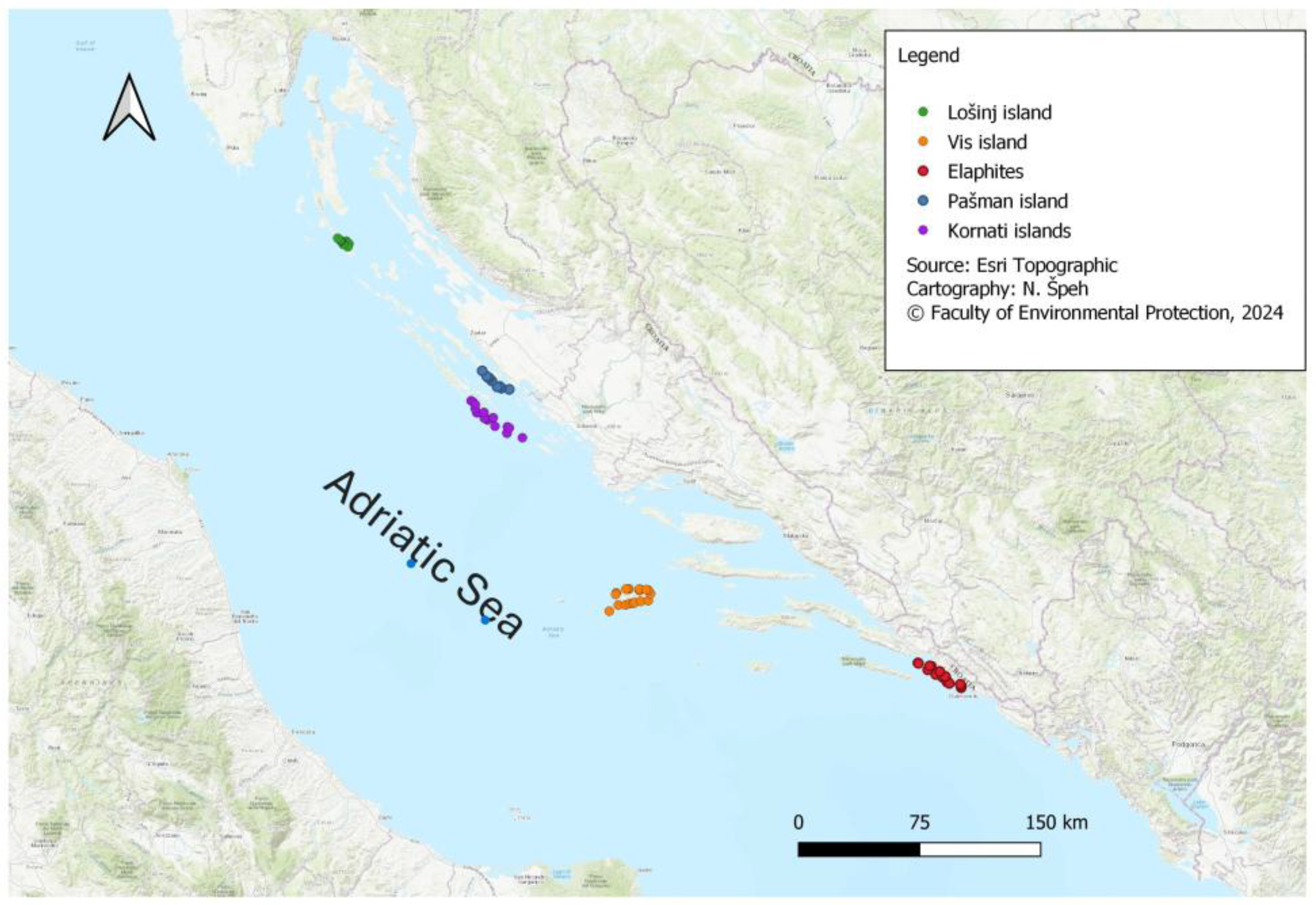

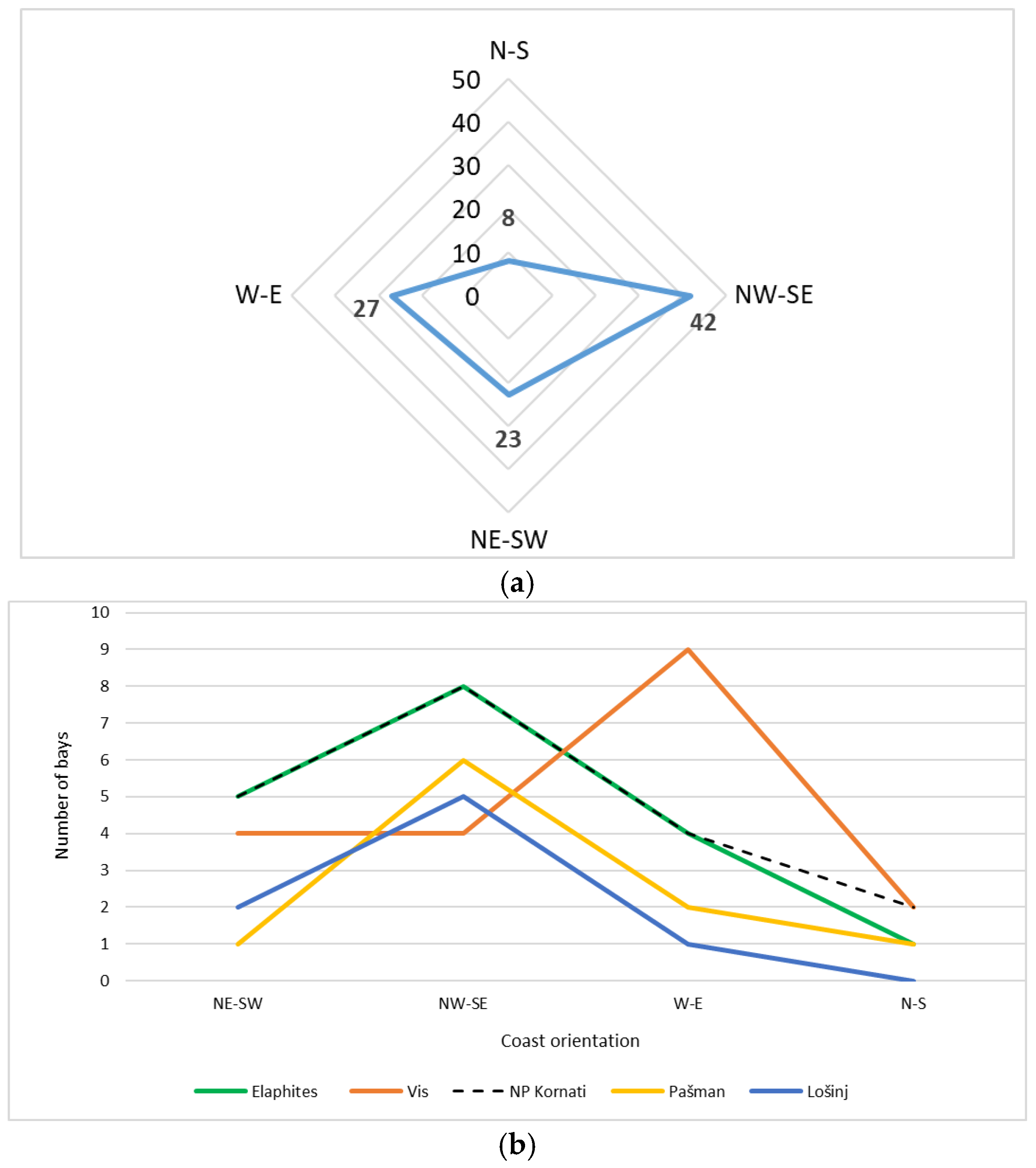
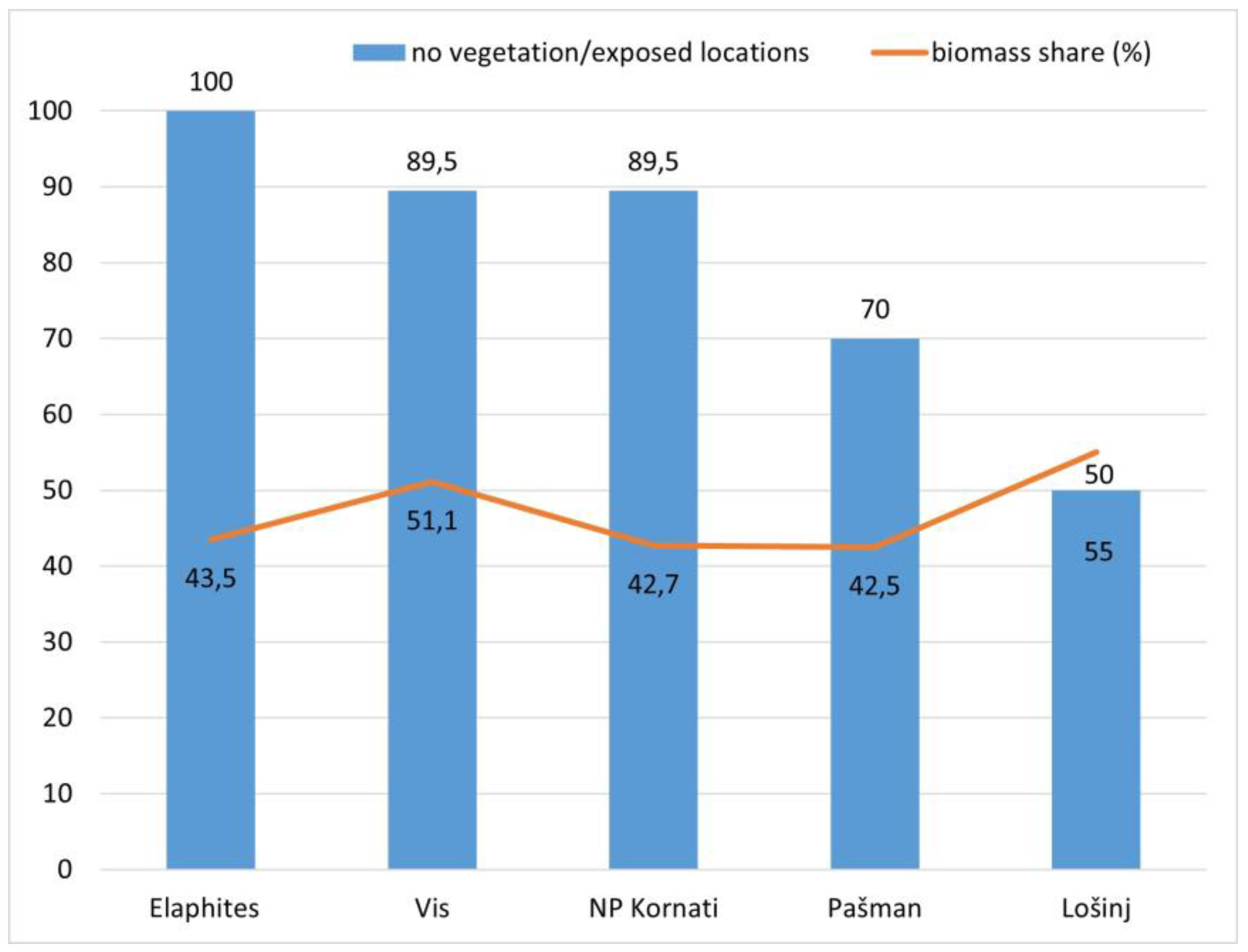
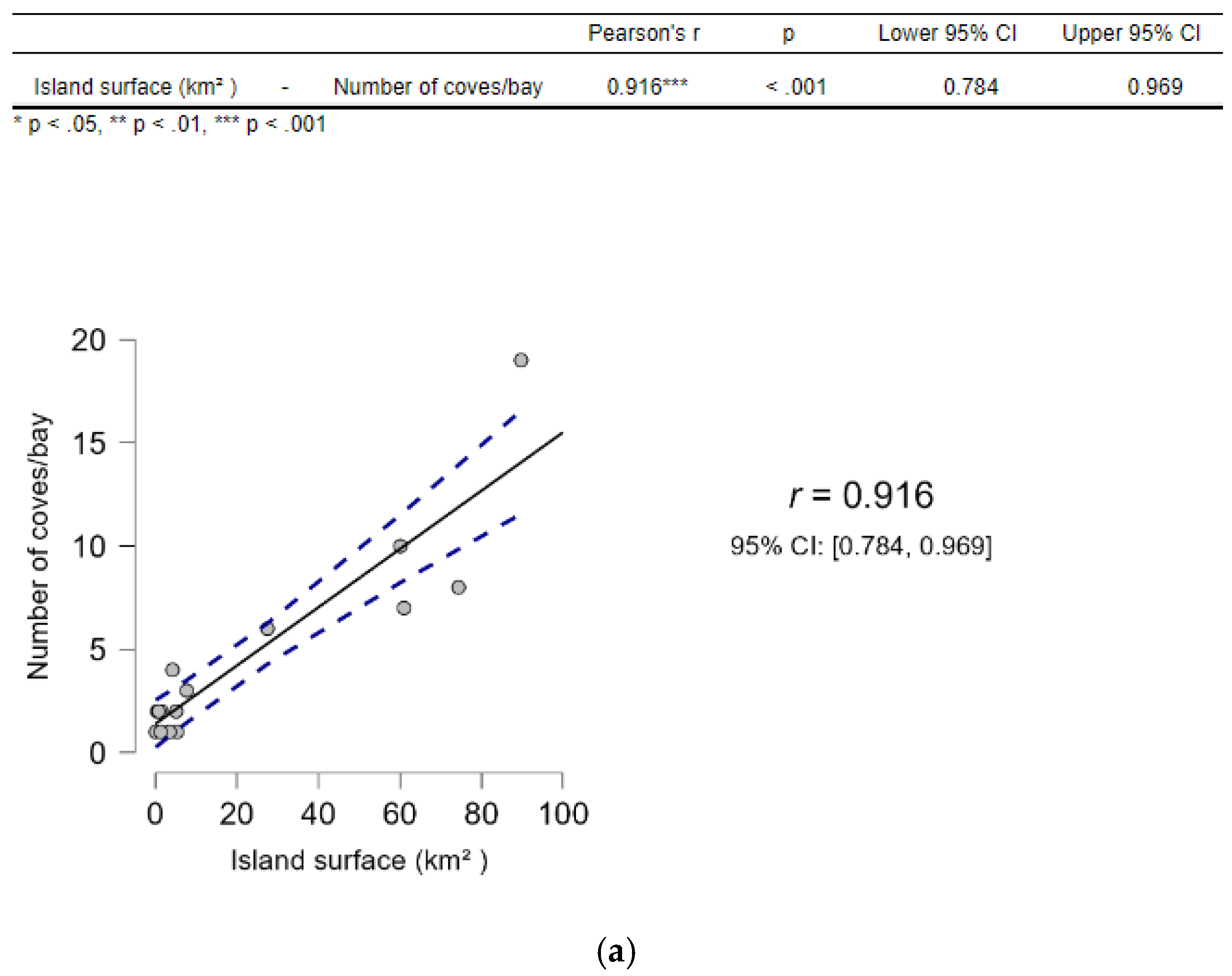

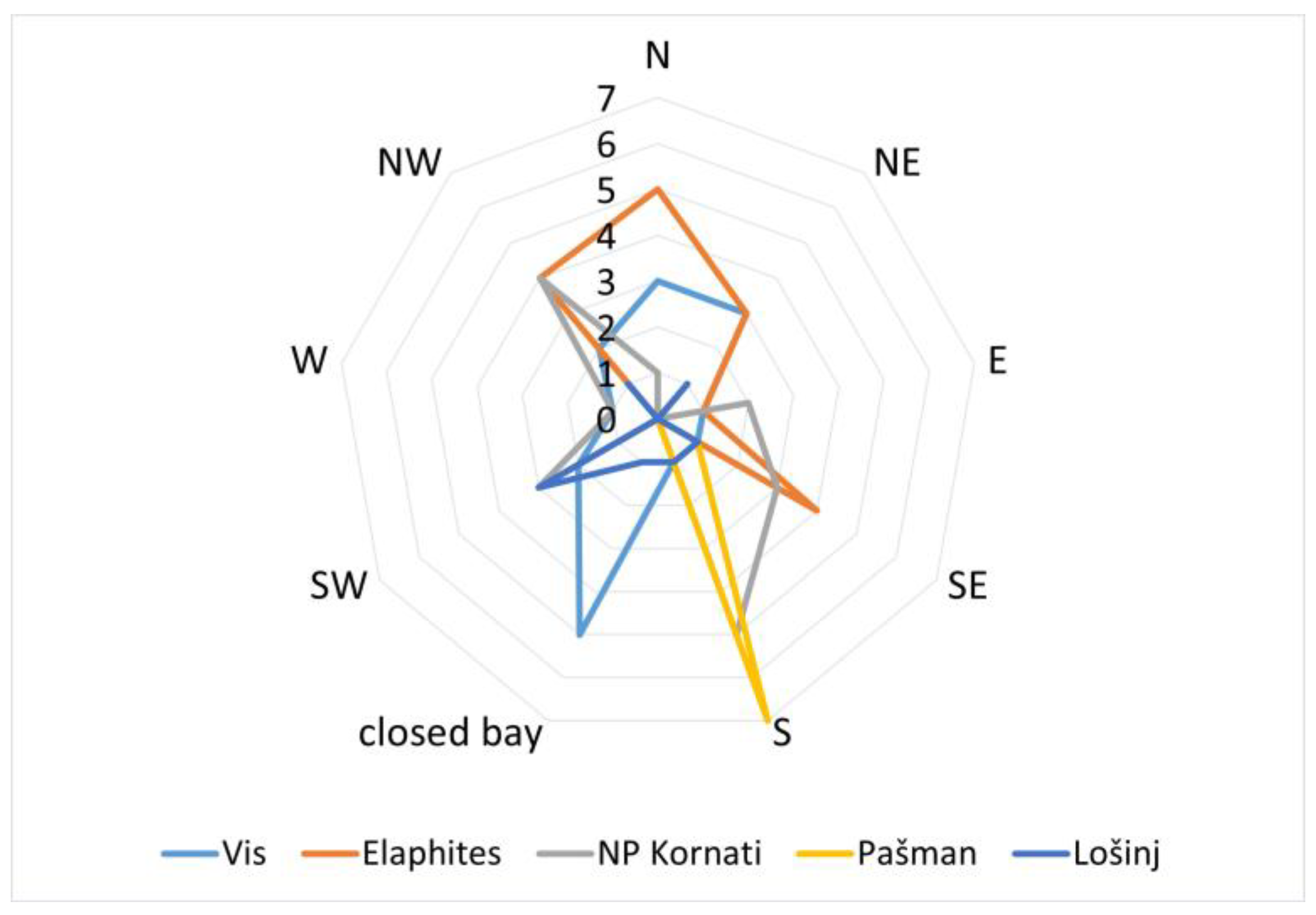
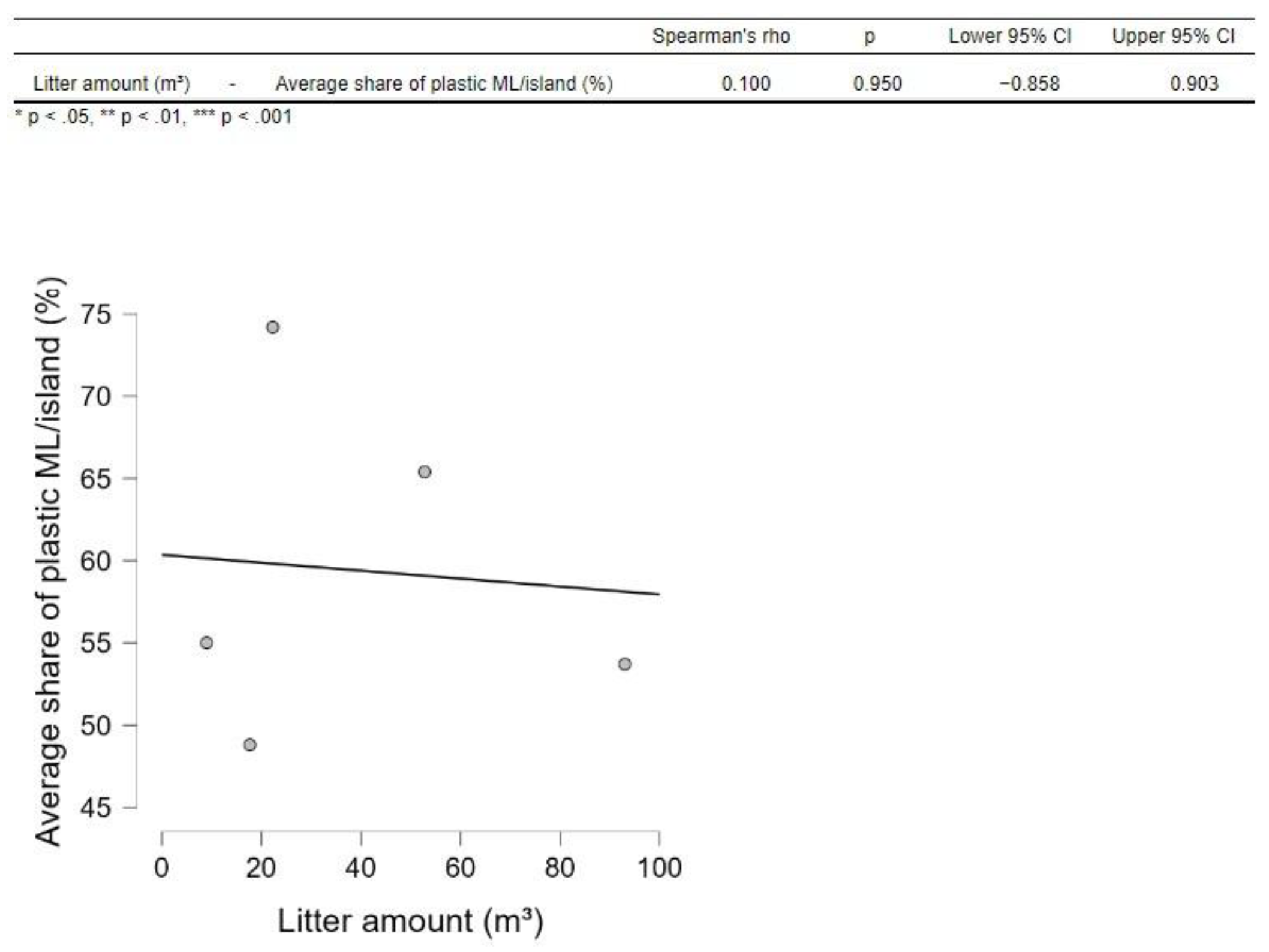
| Island(s)/Share (in %) | NE-SW | NW-SE | W-E | N-S | Total (N) |
|---|---|---|---|---|---|
| Elaphites | 5 (27.8) | 8 (44.4)* | 4 (22.2) | 1 (5.6) | 18 |
| Vis | 4 (21.1) | 4 (21.1) | 9 (47.4)* | 2 (10.5) | 19 |
| Kornati | 5 (26.3) | 8 (42.1)* | 4 (21.1) | 2 (10.5) | 19 |
| Pašman | 1 (10.0) | 6 (60.0)* | 2 (20.0) | 1 (10.0) | 10 |
| Lošinj | 2 (25.0) | 5 (62.5)* | 1(12.5) | 0 (0.0) | 8 |
| Total | 17 | 31* | 20 | 6 | 74 |
| Island(s) /Indicator | Prevailing bays orientation by frequency (decreasing) | ML total amount (m3) | Frequency of ML (average %)* | Presence of plastic in ML (IC+H+C+F) (%) |
|---|---|---|---|---|
| Elaphites | N, NW, SE, NE | 22.3 | IC 5.8, H 41.1 B 24.2, F 28.9 |
74.2 |
| Vis | closed bay, N, NE | 93.0 | IC 7.1, H 33.4 B 45.7, F 13.7 |
53.7 |
| Kornati | S, NW, SE, SW | 52.8 | IC 2.4, H 51.7 B 35.6, F 10.3 |
52.8 |
| Pašman | S | 18.0 | H 24.5, B 34.0 F 41.5 |
55.0 |
| Lošinj | SW | 17.7 | IC 5.0, H 22.5 B 55.0, F 17.5 |
48.8 |
Disclaimer/Publisher’s Note: The statements, opinions and data contained in all publications are solely those of the individual author(s) and contributor(s) and not of MDPI and/or the editor(s). MDPI and/or the editor(s) disclaim responsibility for any injury to people or property resulting from any ideas, methods, instructions or products referred to in the content. |
© 2025 by the authors. Licensee MDPI, Basel, Switzerland. This article is an open access article distributed under the terms and conditions of the Creative Commons Attribution (CC BY) license (http://creativecommons.org/licenses/by/4.0/).





